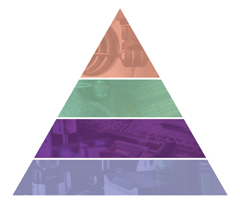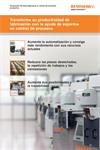Preparación del proceso
El reglaje automático mediante inspección puede ser hasta 10 veces más rápido que los métodos manuales.
Los controles del nivel de preparación de procesos de la pirámide Productive Process Pyramid™ establecen relaciones entre la máquina, la pieza y las herramientas antes de iniciar el mecanizado. Estos controles predictivos automáticos garantizan que la mecanización es correcta desde el principio.
Asegúrese de que la mecanización es precisa desde el principio

La preparación de procesos de la Pirámide trata de las fuentes previsibles de variación, como la ubicación de la pieza, el tamaño de las herramientas y las compensaciones de la máquina, alineando las actividades de mecanizado con la posición real de la pieza.
Estos controles son predictivos y se aplican justo antes de mecanizar.
El reglaje de herramientas establece
- la longitud de la línea de referencia del husillo para establecer una compensación de altura y para comprobar que la longitud se encuentra dentro de la tolerancia especificada
- el diámetro durante el giro para establecer una compensación de tamaño de herramienta
El reglaje de piezas establece
- la identificación del componente para seleccionar el programa NC correcto
- la posición de un elemento de referencia para definir un sistema de coordenadas de trabajo (SCT)
- el tamaño de alojamiento o el componente para determinar la condición de tolerancia y la secuencia de desbaste
- la orientación de un componente (relacionado con el eje de la máquina) para establecer la rotación de coordenadas
El reglaje de máquina establece
- la alineación de un eje giratorio, un utillaje o los elementos de fijación necesarios para colocar y sujetar los componentes
- la posición del centro de rotación de un utillaje y los puntos de referencia de los elementos de fijación
Controles predictivos
El reglaje automático mediante inspección puede ser hasta 10 veces más rápido que los métodos manuales, dejando más tiempo libre para el mecanizado.
Además, la inspección es previsible: conoce de antemano el tiempo de preparación del reglaje y puede hacer las previsiones necesarias.
Los procesos de reglaje utilizados en las inspecciones en la máquina pueden ser controlados completamente por el programa, de forma que no se necesitan operarios cualificados para realizar las mediciones, hacer los cálculos e introducir los cambios de compensación.
Las sondas de inspección de piezas de trabajo de Renishaw, los sistemas de reglaje de herramientas y el software Productivity+™ son unas herramientas imprescindibles para una preparación rápida, automática y repetible de trabajos de mecanizado.
Documentos
-
 Folleto: Soluciones de metrología para un control de procesos productivo
Folleto: Soluciones de metrología para un control de procesos productivo
Transforme su productividad de fabricación con la ayuda de expertos en control de procesos
